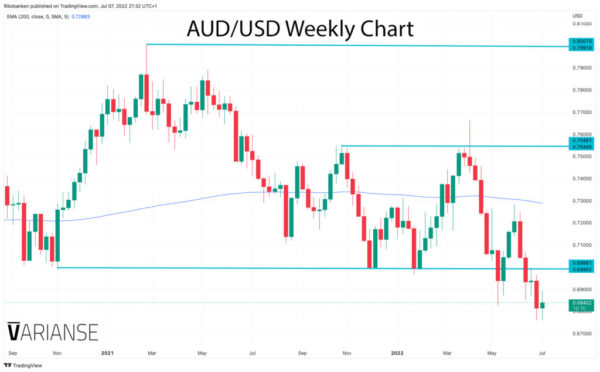- AUD/USD has spend four consecutive weeks below 0.70
- RBA interest rate hike expectations have cooled since June
AUD/USD Under Pressure
AUD/USD has spent four consecutive weeks below 0.70, a region of major support, which also marked the bottom of its longer-term structural range. The gradual pairing back in RBA interest rate hike expectations, global recessionary concerns, and the Fed talking tough on interest rates, all seem to be at play here. Potentially, that doesn’t bode well for AUD/USD in the near term. In my mind, the only fundamental path for the AUD to really outperform is if global inflation pressures ease; that Fed interest rate hike expectations drop dramatically; and global recession is avoided. The way conditions stand at the moment, that seems an unlikely trinity.
RBA Rate Expectations Fall
Only this June, interest rate markets were pricing the RBA policy rate at 4% by year end. At the time of writing, that figure was c 3.2%, while guidance from the RBA sits at 2.5%. Markets, in my opinion, risk a gradual convergence toward the RBA guidance rather than the other way around. That’s not to say the RBA is not serious about fighting inflation, which stood at 5.1% in Q1. Aside from global inflation pressures, Australia’s low unemployment rate and strong Q1 GDP number all warrant tighter monetary policy. Hence why the RBA has raised interest three times this year, most recently by 50 bps in July to 1.35%. More is also likely to come by way of a 50 bps hike in August.
Fast Paced Transmission
Instead, markets may be underestimating the relative speed of RBA monetary policy transmission. This is visible in the housing market, which is financed largely by variable rate mortgages, and is already coming under strain for the current interest rate rises. A recent article in the Guardian newspaper, does a very good job highlighting the level of mortgage stress in the Australian economy. PMI data also points to services sector activity slipping in Q2, after a relatively strong start to April. As a result, the RBA guidance may be closer reality than what’s currently implied by the market.
Narratives Need to Change
On that basis, the RBA is going to have trouble keeping pace with the Fed’s advertised tightening path. That may not be a good outcome for a high yielding currency like AUD/USD. Were the Fed to switch gears after slipping the world into recession, that would likely be equally unfavourable for a growth sensitive currency such as the Australian dollar. In other words, the narrative that suits AUD/USD isn’t currently any of those circulating financial markets at the moment.















